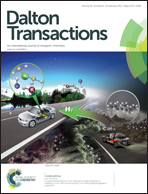Bulk spin-crossover in the complex [FeL(NCS)2] of a tris(pyridyl)ethane-derived N4-ligand—a temperature-dependent crystallographic study†
Abstract
We have recently shown that the vacuum-deposited complex [FeIIL(NCS)2] (L: 1-{6-[1,1-di(pyridin-2-yl)ethyl]-pyridin-2-yl}-N,N-dimethylmethanamine) is capable of a thermally induced spin crossover (SCO) in direct contact with a graphite surface. The SCO significantly differs from the transition behaviour in the bulk phase (powder). In the present work, the assumption of virtually no intermolecular interaction in the powder is confirmed by comparison with the spin transition in acetone solution (T1/2 = 234[3] K, ΔT80 = 58[4] K), as monitored by temperature-dependent UV/Vis spectroscopy. The complex crystallises from chlorocarbons in the form of a number of pseudopolymorphs. Amongst these, the sufficiently stable solvate [FeIIL(NCS)2]·CHCl3 is investigated by variable-temperature single-crystal X-ray diffractometry. Its SCO behaviour (T1/2 = 240[3] K, ΔT80 = 35[4] K) correlates with features of molecular structure that are unambiguously identified by analysis of the tensor of thermal expansion. Following comprehensive comparison of spin-transition properties in different states of aggregation (also in relation to the newly synthesised high-spin iron(II) and iron(III) complexes [FeIICl2L] and [FeIIICl2L]PF6), a mode of adsorption on graphite surfaces is proposed, that complies with all previous findings.
![Graphical abstract: Bulk spin-crossover in the complex [FeL(NCS)2] of a tris(pyridyl)ethane-derived N4-ligand—a temperature-dependent crystallographic study](/en/Image/Get?imageInfo.ImageType=GA&imageInfo.ImageIdentifier.ManuscriptID=C3DT53070A&imageInfo.ImageIdentifier.Year=2014)

 Please wait while we load your content...
Please wait while we load your content...